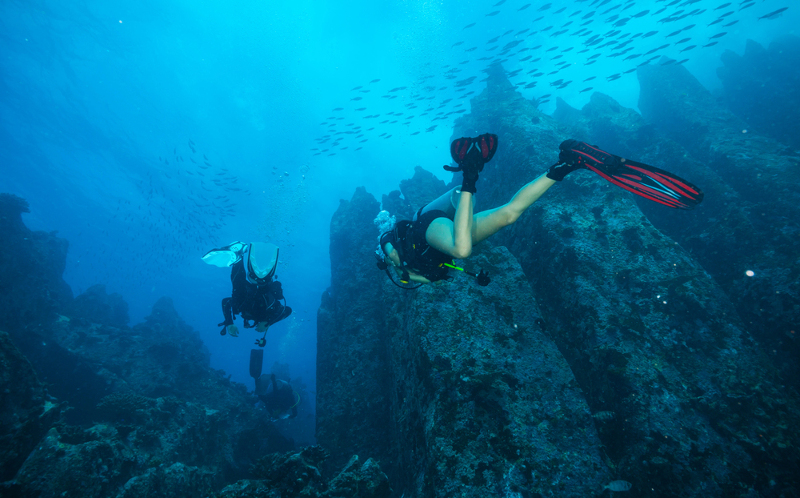Staying close to your dive buddy is important for safe underwater exploration, yet it can be challenging even for seasoned divers. While it sounds simple—stay near and communicate—the underwater environment presents various factors that can complicate this practice. Differences in swimming pace, buoyancy control, visibility changes, and diver preferences can lead to accidental separation. By adopting effective buddy system techniques, you enhance safety and create a more enjoyable diving experience for both of you.
Key Takeaways
- Stay close to your dive partner, ideally within 6-10 feet, and adjust your distance based on visibility and important moments.
- Agree on basic hand signals before the dive to ensure smooth communication underwater.
- Check your air levels together every 500 PSI and coordinate your dive plans to keep similar depths.
- Allow the slower diver to lead and the faster diver to match their speed.
- Go through thorough pre-dive checks together and discuss your dive plan, including depth limits, bottom time, and what to do in case of emergencies.
Pre-Dive Communication Strategies
Before diving, it’s important for divers to set up clear communication methods with their buddies to ensure a safe experience. This pre-dive discussion should cover hand signals, emergency procedures, and specific points of interest during the dive.
Begin by confirming standard signals for commands like “up,” “down,” “stop,” and “low on air.” Also, create unique signals for situations you might encounter, such as indicating interesting marine life or equipment adjustments. Go over your planned dive details, including maximum depth, bottom time, and minimum air pressure for ascent.
Clearly define positioning during the dive, typically keeping a distance of 6-10 feet apart. Discuss who will lead and who will handle navigation. Agree on regular buddy checks underwater, including intervals for air checks and orientation. Lastly, set procedures for what to do if you become separated, including maximum search time and designated meeting points. These strategies help maintain communication throughout the dive while allowing both divers to enjoy the underwater environment safely.

Hand Signals and Safety Checks
Hand signals are the main way scuba buddies communicate underwater, where talking isn’t possible. Divers need to learn key signals before diving, including “okay,” “something’s wrong,” “up,” “down,” and “out of air.” Practicing these signals on land helps build muscle memory for quick communication during dives.
Before each dive, buddies go through important safety checks using the “BWRAF” routine (BCD, Weights, Releases, Air, Final check). Each buddy checks the other’s gear, ensuring BCDs work, weights are secure and can be released, clips function properly, and air tanks have enough pressure. During these checks, buddies also confirm emergency plans and review hand signals for their dive.
Throughout the dive, buddies regularly share the “okay” signal and check each other’s air supply to stay aware of each other’s condition. If visibility drops or conditions change, they may switch to touch signals, keeping physical contact through gentle taps or squeezes to share important information while remaining connected.
Position and Distance Guidelines
When diving with a partner, maintaining the right positioning and distance is essential for safety and clear communication. It’s advisable to stay within 10 feet (3 meters) of your buddy, ideally in a side-by-side or slightly staggered formation for constant visual contact. This setup allows for quick responses to any issues and ensures you can see each other’s signals clearly.
Adjust your distance based on the conditions; in clear water, you can keep a bit more space, while in murky water, closer proximity is better. The lead diver should glance to the side to check their buddy’s position instead of turning around, which helps with balance and control.
Always keep your partner within arm’s reach during important moments like safety stops, descents, and ascents. As you explore dive sites, pay attention to depth, direction, and your buddy’s air usage, and adjust your position as needed. This awareness allows for prompt assistance if problems arise or if sharing air becomes necessary.
Equipment Considerations for Buddy Diving
Preparing for buddy diving requires careful attention to equipment compatibility and redundancy between partners. Both divers should carry similar safety gear, including backup air sources, dive computers, and signaling devices, ensuring they can assist each other in emergencies. Before the dive, partners should familiarize themselves with the location and operation of each other’s gear.
Equipment setups should facilitate easy communication and monitoring between buddies. Dive lights should be positioned for clear hand signals in low visibility, while pressure gauges and computers must be easily visible to both divers. Using the same or compatible dive computers can help ensure matching decompression limits and safety stops.
Key buddy-specific gear includes a long hose setup for air sharing, similar buoyancy control devices for consistent lift, and comparable exposure suits for similar thermal comfort and buoyancy. Weight systems should be accessible to both divers for quick weight drops, and safety markers or other surface signaling devices should be readily available to either partner when necessary.
Dealing with Different Swimming Speeds
Different swimming speeds between dive buddies can pose challenges that need clear communication and planning. Before getting in the water, partners should talk about their usual swimming pace and agree on a comfortable speed for both.
The slower swimmer should lead the pace, while the faster swimmer adjusts accordingly. To help with this, the quicker diver can use a modified flutter kick or swim in a slight zigzag pattern to control their speed. Swimming side-by-side at the same depth allows for easy visual contact and communication through hand signals.
If speed differences become an issue during the dive, partners can use several strategies to stay together. Faster swimmers can create natural resistance by swimming slightly upwards or extending their arms wider to slow down. Additionally, buddies can take turns leading the dive, with the person in front keeping to the agreed pace. Regular stops at interesting spots enable both divers to regroup and ensure no one lags behind. When speed differences are significant, planning shorter distances between stops or choosing dive sites with less current can help.
Managing Limited Visibility Situations
Low visibility underwater presents specific challenges for dive buddies. When visibility decreases, staying connected is essential for safety and enjoyment. Planning ahead, using the right gear, and having clear communication methods can help you navigate these tough conditions.
- Use a bright dive light to show your location, making sweeping motions to enhance visibility for your buddy.
- Stay closer than usual, ideally within arm’s reach, and adjust your distance based on how well you can see.
- If visibility is very poor, establish a physical connection using a buddy line.
- Agree on hand signals that can be easily seen with lights in dark conditions.
- If you get separated, deploy surface marker buoys to help you find each other.
Experienced divers understand that low visibility demands increased attentiveness and adherence to safety guidelines. Practicing emergency protocols when conditions are good prepares teams for tougher situations. Carrying extra signaling devices, like backup lights and noise makers, adds another layer of safety. When visibility worsens, it’s wise to shorten dive time and keep a conservative approach to ensure both divers feel comfortable and in control.
Regrouping After Separation
Even with the best precautions, buddy separation can still happen underwater. When this occurs, following established guidelines helps ensure a safe reunion. The standard procedure involves searching for one minute at your current depth, then slowly ascending to continue the search.
During the search, make a slow 360-degree turn while checking all directions, including above and below. Use your dive light for visibility, and listen for any bubbles that might indicate your buddy’s location. If you don’t find your buddy within the first minute, begin a controlled ascent to your planned reunion depth, usually around 15 feet, while continuing to look.
At the reunion depth, spend no more than one additional minute scanning the area. If you still haven’t located your buddy, surface slowly while making the necessary safety stops. Once you reach the surface, inflate your BCD, look for your buddy’s bubbles or surface marker, and signal the dive boat if needed. After reuniting, check your air supplies and conditions before deciding whether to continue or end the dive.
Buddy System Best Practices
By following buddy system protocols, underwater explorers can enhance their safety and enjoyment. Effective buddy teams ensure clear communication, keep an eye on each other’s air supply, and remain within arm’s reach during dives. Adhering to established practices helps both divers stay safe and make the most of their underwater adventures.
- Perform thorough pre-dive checks using systems like BWRAF (BCD, Weights, Releases, Air, Final check) to ensure gear is functioning properly.
- Agree on hand signals and communication methods before entering the water, including emergency procedures and adjustments to the dive plan.
- Keep a maximum distance of 6 feet between buddies, adjusting as needed based on visibility and dive conditions.
- Regularly check each other’s air levels, typically every 500 PSI, and set turn-around points based on the rule of thirds.
- Synchronize dive profiles, ensuring similar depths and that both divers stay within their training limits.
Practicing these protocols consistently helps buddy teams focus on exploration while maintaining safety. Regular application of these practices builds a solid foundation for effective diving partnerships and enhances the overall diving experience.


